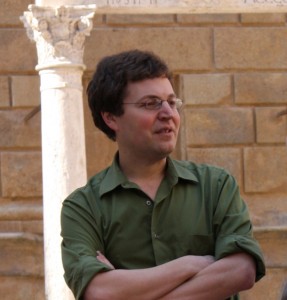
ECLA students enrolled in the elective class “Methods and Interpretations: The Visual Arts” spent an exciting afternoon at the Museum Berggruen in Berlin’s Charlottenburg district. The students confidently took up the challenge of applying visual analysis to major works of European modernism, and the museum provided a perfect setting with its works by Picasso, Matisse, Klee and Giacometti.
The vibrant discussion commenced with a brief overview of how twentieth-century art is different from the Renaissance tradition, and how the canvas is no longer essentially an Albertian window, which, through perspective, allows us to look into another world. The class interpreted “Le Cahier Bleu” (1945) and “Intérieur en Entretat” (1920) by Matisse in the light of how the tenets of realism and naturalism have given way to a new understanding and sensation, which acknowledges the reality of the two-dimensional flat surface, as well as that of the brushstroke. By scrutinizing representative works by Matisse from earlier and later in his career, the students could trace the rising importance of surface and color, and soon found themselves beyond the realm of formal analysis, elaborating on the subjective emotions that a painting provokes in the audience, and on the importance of pure form and of medium as a part of “the message.”
Berggruen’s impressive collection of Picasso paintings constituted an excellent opportunity for discovering how the artist kept transforming and reinventing himself throughout his various periods. The students spent most of the time engaging with cubist works, distilling the essence of the style and experiencing the active role that viewers should adopt in order to decipher the suggested meanings behind increasingly abstract representations. Insightful juxtaposition between Braque and Picasso made it possible to further refine one’s comprehension of both the aesthetic principles behind cubism and the subtle characteristics that make the work of each representative of the movement unique and recognizable.
A preparatory sketch by Picasso for the famous “Les Demoiselles d’Avignon”(1907), presented together with African artifacts, triggered a discussion about the significance of primitive art for modernists, with a special emphasis on the ambiguity of how artists interpreted exotic objects: on the one hand, as a source of inspiration full of vitality and spirituality, and on the other, as items devoid of context onto which pre-conceived Western notions were sometimes applied too hastily.
Another painting by Picasso – “La Minotauromachie” (1936) – served as a brilliant example of the artist’s mythic sensibility and self-produced iconography, in which references to other Picasso works are often more enlightening than an examination of the generally accepted symbolism of particular images in the context of art history. For example, while in other contexts the Minotaur – the part-bull part-man creature from Greek mythology – may stand for the general bestial nature of humans, for Picasso it is often associated with virulent masculine sexuality.
The Berggruen Museum is named after Heinz Berggruen – a prominent German art dealer and collector who left his art-collection to the Prussian Cultural Heritage Foundation, and made it public in 1996. Berggruen, whose passion was modern art from the beginning of the 20th century, died in 2007, having led a remarkable life. Born in 1914, he immigrated to the United States in 1936 to escape from Nazi Germany; held the office of “assistant director” at the San Francisco Museum of Modern Art; had a short passionate affair with painter Frida Kahlo; became Picasso’s art-dealer after the Second World War, and was awarded honorary citizenship of Berlin, as well as the Federal Cross of Merit of Germany. ECLA students in the past (i.e., ISU 2004) have had the honor and pleasure to personally meet Mr. Berggruen during a museum tour, and to listen to his fascinating stories about several of the displayed works.
By Snezhina Kovacheva (’09, Bulgaria)
